They’re invading Normandy again, 75 years after D-Day. So much has changed. One thing hasn’t.
It’s always been about their buddies.
When they parachuted in the dark out of airplanes or splashed into the surf down the ramps of landing craft, they were fighting for liberty, democracy and an end to Nazi tyranny. But those became abstract notions when the bullets started flying and the shells fell. In the terror of combat, they fought for each other.
Died for each other, too, and that’s what sends the survivors back to France, all these years later, in their wheelchairs and their walkers. To pay their respects to the ones who never came home. To shed tears among row after row of white crosses in the cemetery at Colleville-Sur-Mer.
“They’re the real heroes,” said Clair Martin.
The Pacific Beach resident and former Army radio operator is 98, and one of an ever-dwindling number of D-Day survivors. No one knows how many are left among the more than 73,000 Americans who crossed the English Channel on June 6, 1944, for Operation Overlord, the largest air, sea, and land invasion in military history. Organizers of Thursday’s official 75th anniversary ceremony in Normandy are expecting maybe 30 U.S. survivors.
Martin and a handful of other San Diego County vets will be among them, or at associated events over the next week. Thousands of spectators are expected to swarm the region, cheering the survivors wherever they go with standing ovations and free drinks in bars. They will be saluted in speeches by world leaders. People will ask them to autograph T-shirts and hats. They’ll pose for countless photos, tell their stories over and over.
Tom Rice, a retired teacher from Coronado, will be featured in much of the media coverage because, at age 97, the former Army paratrooper is scheduled to jump out of an airplane, re-enacting what he did in the early hours of D-Day, wearing the same boots but this time harnessed to another much younger parachutist.
He has been doing tandem jumps on D-Day for several years now, all of them to honor those killed in the war. The way he sees it, when he came home, he got the chance to spend more than 40 years teaching history and coaching track at Chula Vista and Hilltop high schools. He got to marry and have children. They didn’t.
“I don’t want anybody to forget them,” he said.
When Jack Port goes back to Normandy, it’s as something of a symbol to the French, a living representation of the Army grunts who slogged their way up the beach, fought in the hedgerows, and gave France back its freedom. Touched by the gratitude he felt when he returned for 25th anniversary D-Day events in 1969, he’s made the trip again and again — more than 30 times now — and nourished friendships.
The 97-year-old Oceanside resident has been made an honorary citizen of three Normandy towns. Last year, a school in Saint-Pois was named after him.
This year brought another unexpected tribute: He was asked to go to Portsmouth, England, to be part of a June 5 ceremony hosted by the Queen in the area where allied troops massed to cross the channel on D-Day.
Port said he was honored, but he turned down the invitation. He was worried about getting back to Normandy in time and being rested enough to participate as a speaker in the next day’s commemoration on Utah Beach, where he splashed ashore 75 years ago amid the carnage of machined-gun bodies and shell-blackened landing craft.
“On D-Day, Utah Beach is where I want to be,” he said. “That’s where I need to be.”
———
D-Day is remembered now as an epic triumph, the beginning of the end for Hitler in Western Europe. Three months later, the Allies were in Paris. Eight months after that, the Germans surrendered.
What often gets lost in that memory is how difficult and risky it was to send 155,000 Allied troops, 5,300 planes, 10,000 ships and scores of jeeps, tanks and other equipment into Normandy in one day, breaching 50 miles of enemy fortifications and weaponry to gain a foothold in France. The planning took two years, with military leaders well aware that the Germans had nearly driven earlier amphibious assaults in Sicily, Salerno and Anzio back into the sea.
This time, the weather was bad, too, and the invasion, originally scheduled for June 5, was postponed. When forecasters told Gen. Dwight D. Eisenhower, supreme commander of the Allied forces, that a 12-hour window of clear skies looked probable for June 6, he said, “OK, let’s go.” And he prepared a statement for the press, just in case:
“Our landings in the Cherbourg-Havre area have failed to gain a satisfactory foothold and I have withdrawn the troops. My decision to attack at this time and place was based upon the best information available. The troops, the air and the Navy did all that bravery and devotion to duty could do. If any blame or fault attaches to the attempt it is mine alone.”
Paratroopers like Tom Rice, part of the 101st Airborne Division, were among the earliest to go in.
His C-47 arrived over Normandy at about 1 a.m. German bullets peppered the fuselage. He went out the door first, just as the plane lurched upward, and his left armpit got caught in the door frame. Others jumped over him as he swung back and forth. He finally freed himself, ripping a new Hamilton watch off his wrist in the process, and floated under his parachute toward the ground.
Chaos ensued, as it did almost everywhere that day. Paratroopers were scattered across hundreds of miles of the Contentin Peninsula, and in the dark they tried to find each other, signaling with lights and clickers. Rice became part of a group of two soldiers, then six, then 10.
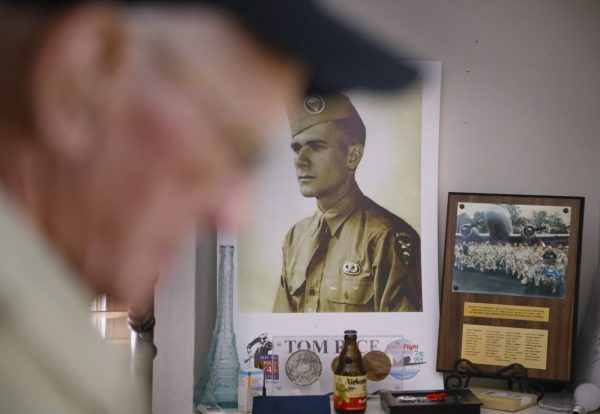
Tom Rice in the foreground, with a photo board of him in the background, taken during his time in the Army during World War II. He was a paratrooper in the 101st Airborne Division and part of the D-Day invasion by Allied forces of France to liberate German-occupied northwestern Europe from Nazi control known as Operation Overlord, photographed at his home in Coronado, California, May 28, 2019. Now 97, on June 5th he’ll parachute over France again. This time he’ll do a tandem jump, part of the 75th anniversary commemoration of D-Day. (Howard Lipin/San Diego Union-Tribune/TNS)
Eventually he was sent with a couple of others to guard a canal lock so the Germans couldn’t flood the surrounding countryside and impede the invasion. They dug foxholes and set a noise trap: tin cans, loaded with rocks, attached to wire strung between garden stakes.
At about 2 a.m., the tin cans danced and Rice and the others started shooting. One German was killed. They made a crude cross out of tree limbs and buried him in a garden. They noticed by looking at his uniform that he was a paratrooper, too.
Rice spent the next month fighting from town to town through Normandy, and jumped again three months later in Operation Market Garden in Holland. He was wounded in the Battle of the Bulge. But it’s D-Day that echoes loudest, sends him back to France, nudges him into parachuting out airplane doors. In a nod to his fabled airborne unit, he’d like to keep jumping until he’s 101.
In recent months, he’s been working out at a gym in Coronado, building up his strength. He’s been doing media interviews. A documentary film crew is following him to France, where in addition to his tandem jump, he’ll attend ceremonial dinners, walk in parades and visit a village that was home to one of his ancestors.
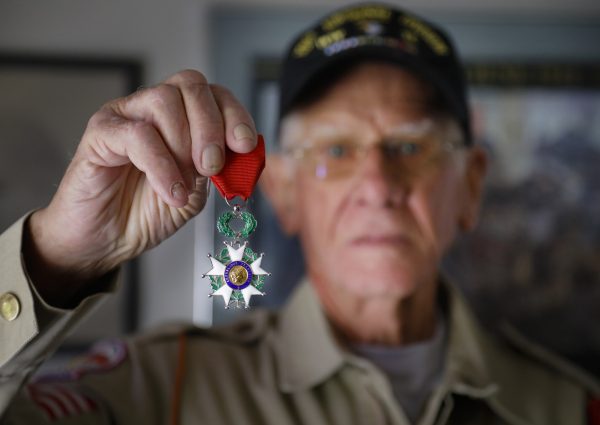
Tom Rice who was an Army paratrooper in the 101st Airborne Division and part of the WWII D-Day invasion by Allied forces of France to liberate German-occupied northwestern Europe from Nazi control known as Operation Overlord, received the French Legion of Honour from the French government. Photographed at his home in Coronado, California, May 28, 2019. Now 97, on June 5th he’ll parachute over France again, part of the 7th anniversary of D-Day. This time he’ll do a tandem jump. (Howard Lipin/San Diego Union-Tribune/TNS)
He’s brought along five wristwatches to hand out, reminders of the one he lost jumping into history 75 years ago.
———
Clair Martin figured his job on D-Day would be straightforward.
After Navy warships used their big guns to wipe out the German coastal defenses, his artillery group in the 29th Infantry Division would come ashore at Omaha Beach. He and his partner would set up their radio, and they’d be in business.
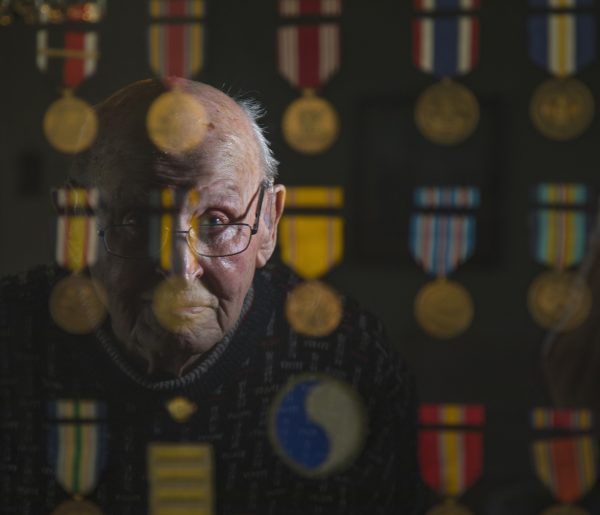
World War II Army and D-Day veteran Clair Martin’s image is reflected in the glass of a display of his military awards and decorations in his Pacific Beach home in San Diego, California, May 29, 2019. Now 98-years-old, he was a soldier in the 29th Infantry Division when he and countless others stormed Omaha Beach in Normandy, France on June 6, 1944, to defeat Hitler’s Germany, part of the largest sea invasion in history. He will attend the 75th anniversary commemoration in Normandy on June 6. (Howard Lipin/San Diego Union-Tribune/TNS)
Then the ramp of their landing craft came down and the German defenses were very much still in operation. Omaha Beach became a killing zone.
“The Germans had us cold turkey,” Martin said. “That’s all there is to it.”
He and his partner scrambled off the ship and behind a sand berm. They put the radio together but it didn’t work, a sign of things to come. Another soldier came up to their position with a mortar tube, dropped in a shell — and nothing. It was a dud. Someone else came up with a bangalore torpedo to blow a hole in one of the barriers the Germans had erected in the surf. It was a dud, too.
Minutes passed, then hours. “I didn’t think we were ever going to get off the beach,” he said.
They did, and Martin spent the next several weeks fighting in the hedgerows surrounding the farms and towns of Normandy. Heart-stopping moments were never far away. He awoke one afternoon from a nap in his foxhole to see a German staring down at him. Certain he was about to be shot, Martin was relieved to see an American GI look down at him, too. The German, it turned out, was a prisoner.
Martin returned to Normandy five years ago, for the 70th anniversary. He wound up on the stage at the official D-Day ceremony. Then-President Barack Obama shook his hand.
This time he’s on a tour that will stop at museums and battle sites, including Omaha Beach. He knows people everywhere will treat him like a hero, a sentiment he tries to deflect by pointing to the ones who paid the ultimate price.
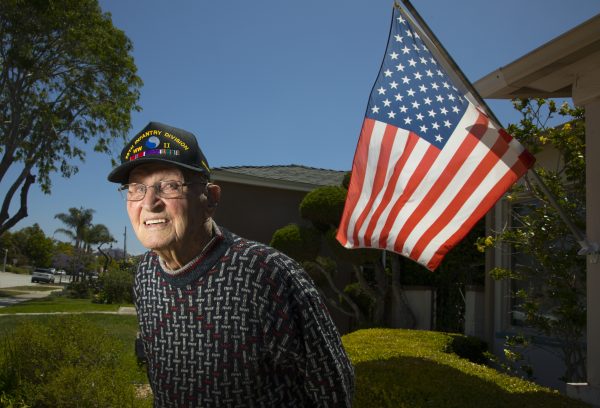
World War II Army and D-Day veteran Clair Martin at his Pacific Beach home in San Diego, California, May 29, 2019. Now 98-years-old, he was a soldier in the 29th Infantry Division when he and countless others stormed Omaha Beach in Normandy, France on June 6, 1944, to defeat Hitler’s Germany, part of the largest sea invasion in history. He will attend the 75th anniversary commemoration in Normandy on June 6. (Howard Lipin/San Diego Union-Tribune/TNS)
“It’s an emotional time for him,” his wife, Martha said. “He can usually hold it together until they play Taps. Then the tears fall.”
———
Jack Port knows the feeling.
He, too, resists any suggestions of bravery. Ask him about D-Day and the first thing he usually talks about is how scared he was, how he dropped his rifle on Utah Beach and how, on the first night, he dug his foxhole so deep he had a hard time climbing out in the morning.
Later Port earned a Bronze Star and a Purple Heart fighting with the 4th Infantry, but he doesn’t dwell on those. “We had a job to do,” he said, “and we did it.”
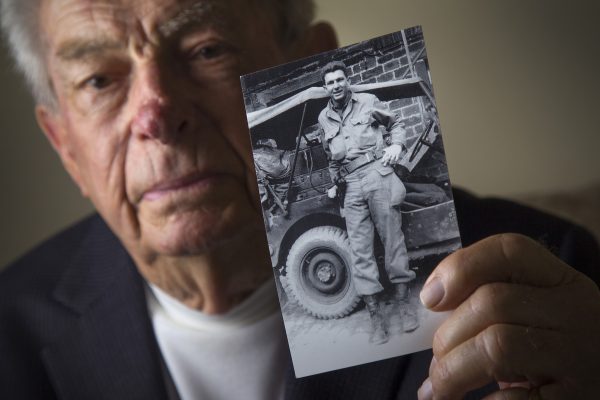
Oceanside resident Jack Port was 22 when he took part in the D-Day invasion in France. He stays with the same family when he returns to Normandy. The French, especially in that area, are so appreciative of their liberation. (Howard Lipin/San Diego Union-Tribune/TNS)
He’d rather talk about how grateful the people in Normandy are, even now. The school in Saint-Pois named after him was dedicated last year, but he couldn’t attend because his wife was sick. So the school is holding another dedication ceremony for him this year.
“In every village and every town, they appreciate the Americans so much,” Port said. “D-Day is a big deal to them. They know it has everything to do with their freedom.”
———
© 2019 The San Diego Union-Tribune
Distributed by Tribune Content Agency, LLC.



